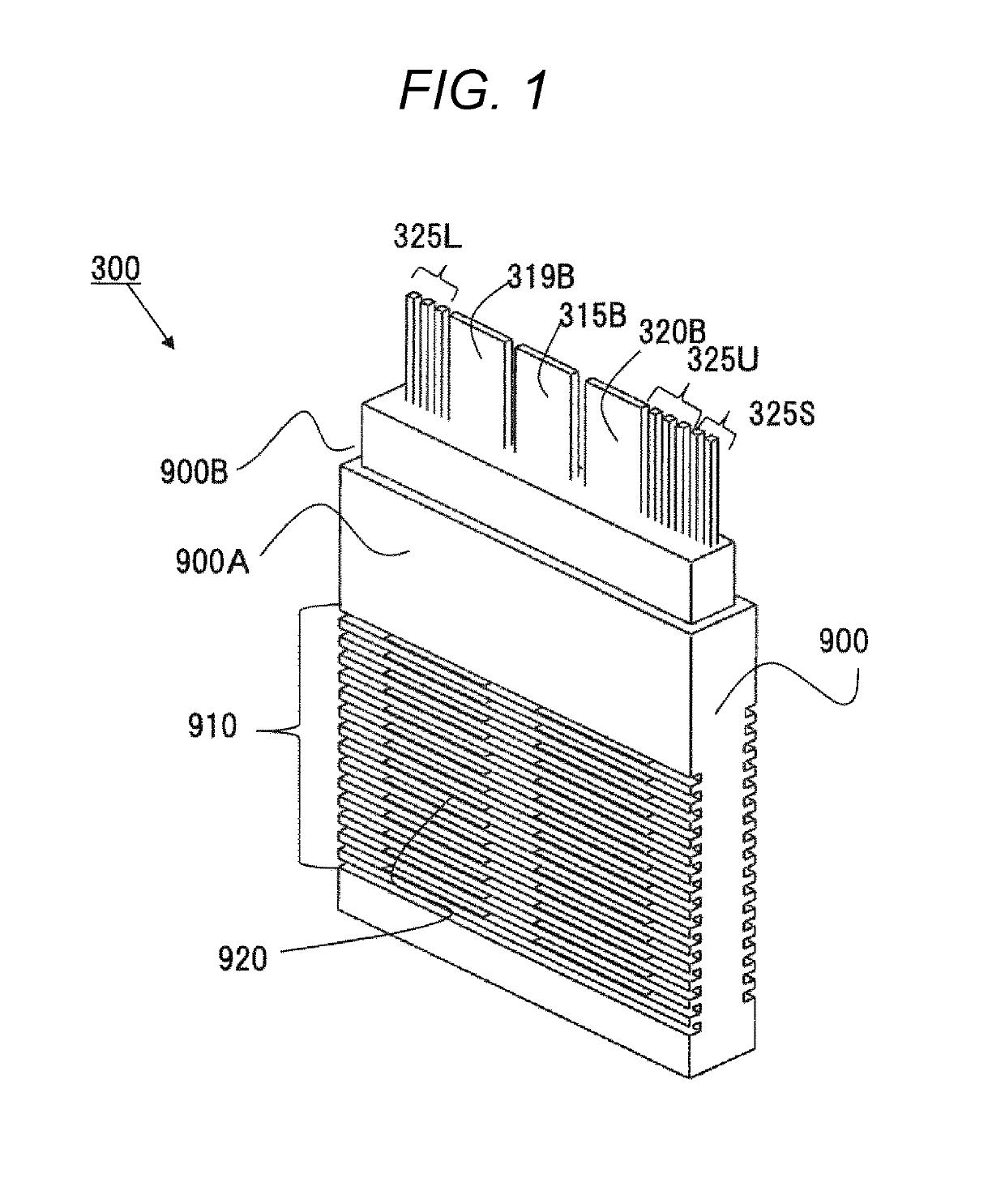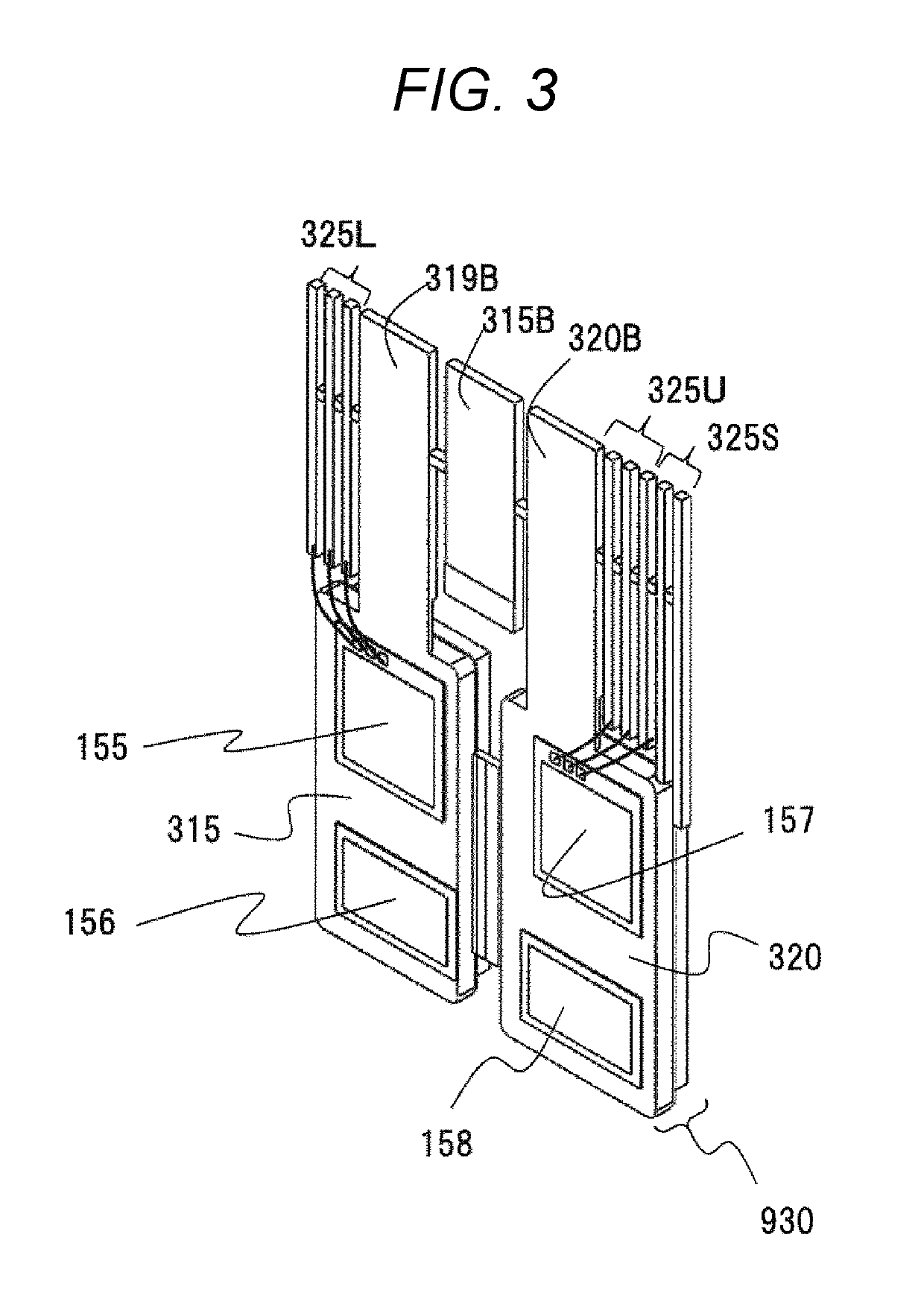Power semiconductor module, power conversion device using same, and method for manufacturing power conversion device
- Summary
- Abstract
- Description
- Claims
- Application Information
AI Technical Summary
Benefits of technology
Problems solved by technology
Method used
Image
Examples
example 1
[0032]FIG. 1 is a perspective view of a power semiconductor module 300 of the present embodiment. The power semiconductor module 300 includes: a sealing resin 900 as a case that houses a power semiconductor; terminals 315B and 319B on a DC side; a terminal 320B on an AC side; and signal terminals 325U, 325L, and 325S.
[0033]The sealing resin 900 seals a power semiconductor element mounted on a metal conductor such as a lead frame 315 and a ceramic substrate wiring to be described later. The terminal 315B, the terminal 319B, and the terminal 320B protrude from one surface of the sealing resin 900 and are arranged in a line such that side surfaces of adjacent terminals oppose each other. A step, configured to form a seal structure in a seal portion 900B, is formed on the sealing resin 900 on a side where these terminals protrude.
[0034]When the power semiconductor module 300 is fixed to a flow path forming body 1000, a first fixing material 901 and a second fixing material 902 arranged ...
example 2
[0074]A second embodiment of the present invention is different from the first embodiment in terms that a thermosetting silicone resin cured product having an elastic modulus of 2 MPa is used as the first fixing material 901. The moisture-curable silicone resin used in the first embodiment requires one to several days for curing and the production speed is low. On the other hand, a curing condition of the thermosetting silicone resin is as short as one hour at 100° C. so that the production speed is high. Since the thermosetting epoxy resin used for the second fixing material 902 and the silicone resin have different solubility parameters and are not compatible, and thus, are not mixed with each other even if being applied in an uncured states so that it is possible to obtain a cured product in a two-layer state. After applying the thermosetting silicone resin of the first fixing material 901, the thermosetting epoxy resin of the second fixing material 902 is applied in the uncured ...
example 3
[0075]FIG. 16 is a schematic view illustrating a sectional structure of the power conversion device 200 according to a third embodiment. A difference from the first embodiment is that a urethane resin cured product having an elastic modulus of 2 MPa is used as the first fixing material 901 and a resin plate having an elastic modulus of 18 GPa consisting of PPS mechanically fixed to the flow path forming body 1000 is used as the second fixing material 902. As the urethane resin, a two-component waterproof urethane resin was used. A curing condition is two hours at 100° C. Since the second fixing material is mechanically fixed, there is an effect that production speed is high. In addition, a urethane resin is superior in reactivity to an epoxy resin, and thus, there is an effect that it is possible to reduce energy required for the effect. The urethane resin as the first fixing material 901 is injected from above the second fixing material 902. As a result, there is an effect that mov...
PUM
 Login to View More
Login to View More Abstract
Description
Claims
Application Information
 Login to View More
Login to View More - R&D
- Intellectual Property
- Life Sciences
- Materials
- Tech Scout
- Unparalleled Data Quality
- Higher Quality Content
- 60% Fewer Hallucinations
Browse by: Latest US Patents, China's latest patents, Technical Efficacy Thesaurus, Application Domain, Technology Topic, Popular Technical Reports.
© 2025 PatSnap. All rights reserved.Legal|Privacy policy|Modern Slavery Act Transparency Statement|Sitemap|About US| Contact US: help@patsnap.com



